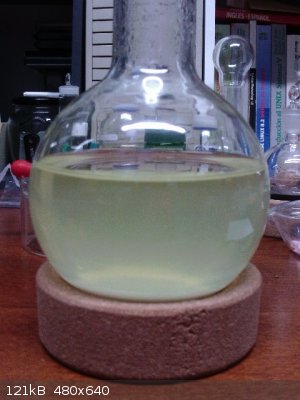
Boffis - 20-10-2019 at 02:09
Has anyone ever tried to prepare ferrous tartarate? I want some as a catalyst for a Fenton type oxidation of tartaric acid so to keep the unnecessary
ions to a minimum I decided to try dissolving iron powder in tartaric acid. In one of the papers I read this was described briefly but I can't find it
again.
Anyhow I added 4g (an excess) of fine iron fillings to 10g of lab grade tartaric acid in 100ml of water and gently warmed. To my surprise a vigorous
reaction set in and copious amounts of unpleasant smelling hydrogen were evolved. I left it fizzing away, when I returned 30minutes later the contents
of the beaker had set into a semi-solid pale bluish grey custard like mass. Warming only makes it glug as the hydrogen is evoved more quickly and the
bubbles unit before reaching the surface.
When the reaction appeared to have ceased and most of the iron dissolved I diluted the thick creamy mass to 300ml with water, heated to boiling and
filtered hot. Nothing has crystallised from the filtrate and it is quite colourless. The filter cake is drying but is pale bluish grey.
Is ferrous tartarate insoluble? or have I reduced the tartaric to something else. I found a reference to the preparation of ferrous tartarate 2,5
hydrate but its in a very obscure Czech journal not available online and another that states that it is a red solid.
Anyone any helpful experience?
Just done the next obvious experiment and mixed 10g of tartaric acid in 100ml of water carefully neutralised with 10M NaOH solution and then mexed it
with 18.3g of ferrous sulphate dissolved in 100ml of water plus 2ml of 32% sulphuric acid and a little iron powder to ensure that any ferric iron was
reduced. The latter solution was filtered before mixing.
Initially the solution turn greenish yellow then very slowly a pale precipitate has started to form. What worries me about this technique is the
possible formation of a sodium tartaratoferrate II complex while the tartarate ion concnetration is still high and then only part of the iron is
turned into tartarate.
The crystalline ppt was filtered of and dried to give a pale yellow green solid that is sparingly soluble in the cold but more so in hot water.
[Edited on 20-10-2019 by Boffis]
[Edited on 20-10-2019 by Boffis]
Waffles SS - 20-10-2019 at 11:56
All possible way for synthesis ferrous tartarate
Attachment: Ferrous tartarate.pdf (82kB)
This file has been downloaded 743 times
[Edited on 21-10-2019 by Waffles SS]
Boffis - 21-10-2019 at 02:13
Many thanks Waffles. Interestingly I have already used two of the methods and got what appear to be different product. However, I have now found the
original paper by Fenton (Trans. Chem. Soc. 1894 v65 p899). It was Fenton's original paper on the catalytic use of ferrous iron with hydrogen
peroxide.
Interestingly he suggests the use of only 1/250 M equivalence of iron is dissolved in the tartaric acid or ferrous tartrate precipitates. So clearly
ferrous tartrate (or is it tartarate?) is sparingly soluble and this is my observation too. When pure and completely unoxidised it is probably a pale
bluish grey but the crystalline material prepared by double decomposition is a pale greenish grey.
Some photographs of my experiments:
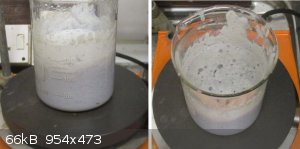
The bluish grey reaction mixture from iron filings in tartaric acid
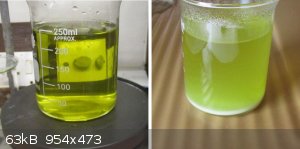
The solution that results from ferrous sulphate and sodium tartarate, on the right, starting the precipitate ferrous tartarate
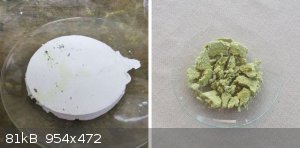
Left; the fresh filter cake from the iron method Right; the fresh crystalline ppt from the ferrous sulphate method
pneumatician - 13-4-2020 at 09:44
hi, yesterday I make this too. With a saturated distilled water of tartaric acid (TA). I put 15 gm of iron in fillings. Soon the mix get a lime
yellow-green color. I raised temp under boiling and a lot of fizzing but not too much unplesand odor.
The pics are after cooling overnight. The iron displaced TA from water? you can see 3 layers, iron undisolved at bottom, a milky layer and the yellow
green water.
Have you acces to the docs? waht say about of the method of boiling??
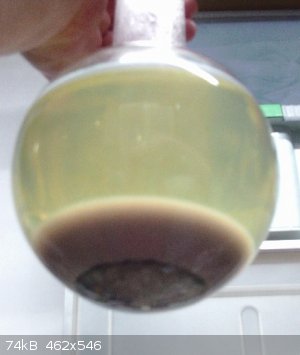
[Edited on 13-4-2020 by pneumatician]
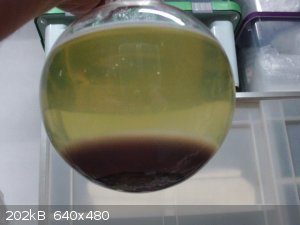
[Edited on 13-4-2020 by pneumatician]
